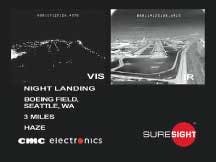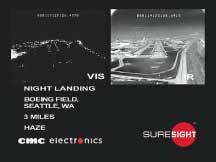Sensors
Bombardier business jet to get enhanced vision sensors from CMC Electronics
Avionics designers at Thales Avionics in Villacoublay Cedex, France, needed infrared sensors for the enhanced vision system (EVS) they are integrating for the Bombardier Global Express long-range business jet. They found their solution in the SureSight EVS infrared sensor from CMC Electronics in Ville Saint-Laurent, Quebec.
"We have patiently waited for this technology to mature and so are especially pleased to be able to offer to our customers a superior enhanced vision system using SureSight, the second-generation EVS sensor from CMC Electronics," says Peter Edwards, president of Bombardier Business Aircraft.
CMC experts developed their SureSight sensor family to enhance flight crew situational awareness by helping them see through fog, haze, precipitation, and darkness.
The enhanced vision system provides an image on a head-up display, on a head-down display, or both, to enable pilot and co-pilot to see the terrain and airport area in low-visibility conditions. The system projects pictures from imaging infrared sensors onto the cockpit displays.
CMC officials have completed two sets of developmental flight trials with their company's sensor, including more than 70 approaches in various adverse weather conditions, company officials say.
"We are pleased and very confident to work with CMC Electronics on this important program, given their extensive infrared sensor experience spanning the past 40 years," says Jean-Pierre Mortreaux, president and chief executive officer of Thales Avionics North America.
For more information, contact CMC Electronics by phone at 514-748-3148, by fax at 514-748-3100, by post at 600 Dr. Frederik Philips Blvd., Ville Saint-Laurent, Quebec, Canada H4M 2S9, or on the World Wide Web at http://www.cmcelectronics.ca/.
Components
Boeing turns to Interstate Electronics for GPS boost to combat radios
Radio designers at the Boeing Co. Integrated Defense Systems division in St. Louis needed global positioning system (GPS) receivers for the Combat Survivor Evader Locator program, otherwise known as CSEL. They found their solution from Interstate Electronics Corp. in Anaheim, Calif.
Interstate Electronics won a $4.4 million one-year contract from Boeing Integrated Defense to supply the TruTrak locator GPS receivers for the CSEL handheld radios.
The CSEL helps search-and-rescue experts locate downed aircraft pilots. The heart of the TruTrak locator receiver is the Xfactor SAASM module, which has approval of the U.S. GPS Joint Program Office.
SAASM, which stands for Selective Availability Anti-Spoofing Module, is a tamper-resistant multichip module that gives authorized users access to the U.S. Department of Defense GPS precise positioning service signal, which is more accurate than commercially available GPS signals.
Total production of CSEL radios could be as many as 53,000 units over the next seven years, Interstate Electronics officials say.
For more information contact Interstate Electronics by phone at 714-758-0500, by fax at 714-758-4148, by post at 602 East Vermont Ave., P.O. Box 3117, Anaheim, Calif. 92803-3117, or on the World Wide Web at http://www.iechome.com/.
Computers
Alenia Marconi looks to Primagraphics for radar scan converters
Systems integrators at Alenia Marconi Systems in Farlington, England, needed radar input and scan converter systems for the British Royal Navy's fleet of destroyer warships. They found their solution from Primagraphics of Litlington, England.
Alenia Marconi systems integrators will use the Primagraphics equipment with the new flat panel displays, processors, and software in the command and control consoles aboard every vessel in the Royal Navy's fleet of Type 42 destroyers. The first ship to be upgraded with the new equipment will be HMS Gloucester.
Primagraphics is providing the equipment under terms of a $4.4 million contract.
Alenia Marconi won its latest $21.5 million contract from the United Kingdom Ministry of Defence to build the Action Data Automated Weapon System — otherwise known as ADAWS — last June.
The ADAWS command and control system is for anti-air warfare, fighter control, missile direction, naval gunfire support, and anti submarine warfare. The new upgraded equipment will provide the Royal Navy with modern color display systems in every console.
"We were extremely impressed by Primagraphics' professional, responsive and flexible approach to this program," says Frank Thompson, senior project manager at Alenia Marconi. "Not only did they provide a cost-effective, fully integrated system, the company's support engineers worked in partnership with our team to ensure that the customer qualification process was completely successful."
Primagraphics will supply Alenia Marconi with PCI hardware and software from the Primagraphics commercial-off-the-shelf (COTS) METRO product range including its Advantage Plus PCI radar scan converter and its Virgo PCI radar input card.
For more information contact Primagraphics by phone at 011-44-1763-852222, by fax at 011-44-1763-853324, by e-mail at [email protected], by post at Primagraphics Ltd., New Cambridge House, Litlington, Nr. Royston, Herts, SG8 0SS, England, or on the World Wide Web at http://www.primagraphics.net.
Computer peripherals
DOD chooses Teac rugged mass memory unit for Navy's S-3B aircraft.
U.S. Navy officials needed a ruggedized mass memory unit (MMU) for the S-3B carrier-based surveillance aircraft. They found their solution in the S-3B solid-state MMUs from Teac America in Montebello, Calif.
Teac won an $11 million contract from the U.S. Naval Inventory Control Point to provide 126 S-3B solid-state MMUs by December 2003.
Teac's solid-state memory system records two channels of video and stores mission planning data for the main computer system, and replaces the current USH-42 recorder/reproducer, as well as a hard disk digital memory unit, Teac officials say.
The S-3B memory project represents the navy's shift to reliable solid-state memory in digital solid-state video recording, and mission data recording, company officials say.
The S-3B MMU has Teac's standard MDR-80 mission data recorder with Teac scan converter and interface electronics. The unit also has MPEG-2 compression to record two video sources to a 14-gigabyte solid-state removable memory module.
The new unit is a form, fit, and function line-replaceable unit replacement of the Teac V-80 airborne video tape recorder, which currently flies on most U.S. Navy fighters, company officials say.
For more information contact Teac by phone at 323-726-0303, by fax at 323-727-7656, by post at 7733 Telegraph Road, Montebello, Calif. 90640, or on the World Wide Web at http://www.teac.com/.thalescomputers.com/.
Communications equipment
General Dynamics looks to Rockwell Collins for networking capability
Systems integrators at the General Dynamics C4 Systems division in Taunton, Mass., needed networking capability for the U.S. Army Warfighter Information Network-Tactical, otherwise known as WIN-T. They found their solution from engineers at Rockwell Collins in Cedar Rapids, Iowa.
WIN-T, which will help Army experts create a seamless battlefield network, will use commercially developed components and standards to help soldiers communicate by voice, video, and data over wired or wireless systems. It handles battlefield communications from the theater level down to separate battalions.
The idea behind WIN-T is to enable the Army to concentrate combat power by means other than massing its forces, which officials say will make relatively small units more deadly and effective than they are today.
Rockwell Collins engineers will use the networking technology they developed for the Army's Multifunctional On-the-Move Secure Adaptive Integrated Communications program — better known as MOSAIC. Rockwell Collins developed MOSAIC technology for the Army Communications-Electronics Command at Fort Monmouth, N.J.
MOSAIC will ensure that important messages are ranked, transferred, and received throughout the tactical battlefield network, Rockwell Collins officials say.
One part of the Army's tactical battlefield network is the Joint Tactical Radio System (JTRS) Cluster 1 program, which uses the Wideband Networking Waveform, otherwise known as WNW.
For more information contact Rockwell Collins by phone at 319-295-1000, by fax at 319-295-5429, by post at 400 Collins Road NE, Cedar Rapids, Iowa 52498, or on the World Wide Web at http://www.rockwellcollins.com/.




